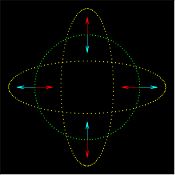To detect the effects of a passage of a gravitational wave is not trivial, this is because a passing gravitational wave will interact with all particles it comes into contact with. It is therefore very difficult for us to define a reference particle to measure this interaction against, unlike in electromagnetics where uncharged particles can be used as a reference point to measure the relative motion of charged particles.


The images above show the effect a gravitational wave travelling perpendicular to the screen would have on a ring of free particles. The two different patterns correspond to the two different polarisations of the waves. As can be seen, the ring will stretch and squeeze as the wave passes.
Mission impossible
The interaction of gravitational waves with matter is minuscule compared to that of radio waves with charged particles. For instance, a supernova explosion in our own galaxy would emit pretty strong gravitational raidation, yet a 1 km ring would deform no more than a one thousandth the size of an atomic nucleus. This has made direct detection of gravitational waves extremely challenging but current detectors have already achieved such sensitivities and there are plans to improve further.
A clear picture
One thing good about the weakness of gravitational interaction is that gravitational radiation travels unscathed even over cosmological distances. This should enable us to obtain a precise picture of their sources. This is in contrast to light and radio waves which interact strongly with charged particles, and are therefore easier to detect, but are scattered endlessly before reaching us and therefore reveal only a fuzzy picture of their sources.
For example, when a star exhausts its nuclear fuel the core implodes to form a neutron star or a black hole and the outer layers suffer a bounce from this implosion, leading to a supernova. What astronomers normally witness is the glow produced by this explosion, a day or two after the collapse. The fantastic brightness of a supernova, amounting to the energy produced by 100 stars like the Sun during their entire lifetimes of more than 10 billion years, will always be a blinding radiation preventing us to get to the processes that take place in the core. However, when the same process is observed using a gravitational wave antenna we will be able to get a picture of what may be happening in the inner cores since gravitational waves emitted in the process will reach us virtually unaffected by the action taking place in the outer regions.





